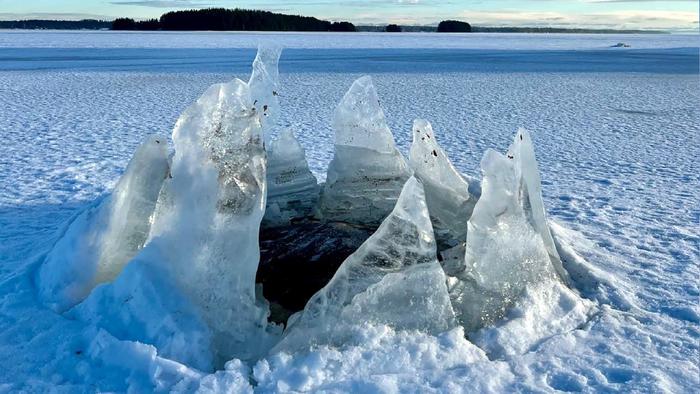In the serene, picturesque landscapes of northern Sweden lies Lake Siljan, a remarkable body of water steeped in folklore and scientific intrigue. This famed lake, known for its natural beauty, has recently emerged as a focal point in environmental research due to an unexpected phenomenon: anomalous methane emissions. Researchers from Chalmers University of Technology have returned to this enchanting locale, armed with innovative measurement techniques that promise to unveil the secrets beneath its icy surface.
The enchantment of winter at Lake Siljan often leads to the formation of ice holes that reappear consistently at certain spots each year. For decades, locals have been perplexed by these phenomena, pondering the reasons behind such peculiar occurrences. The science community is now stepping in, seeking to demystify this environmental conundrum that lies beneath the winter cloak of ice.
Employing a groundbreaking measurement method, the team at Chalmers University has conducted extensive examinations of the lake’s surface and subsurface dynamics. Their findings reveal that significant quantities of methane are being emitted from several locations within the lake. The gaseous emissions are believed to be responsible for the persistent holes that mar the otherwise pristine ice-covered surface. Methane, primarily known as a potent greenhouse gas, has garnered attention for its environmental implications, particularly regarding climate change.
The phenomenon observed at Lake Siljan highlights a crucial aspect of methane emissions in freshwater lakes, where organic material decomposition can produce methane—a process accelerated by rising temperatures. As climate change continues to alter the natural landscape, understanding the dynamics of these emissions becomes paramount for crafting effective environmental policies and strategies. This research may provide vital insights into the interactions between climate change and freshwater ecosystems.
Furthermore, the implications of methane emissions extend beyond ecological effects. As an influential greenhouse gas, methane is significantly more effective at trapping heat in the atmosphere compared to carbon dioxide over a short period. This fact further underscores the urgency of understanding methane dynamics in various environments, including lakes, which have traditionally been overlooked in broader climate discussions.
Lake Siljan serves as a relevant laboratory for examining how environmental shifts can lead to unforeseen emissions patterns. The discovery of hotspots of methane release in this region may prompt a reevaluation of how freshwater bodies contribute to climate change. It opens new avenues for research that connects hydrology, limnology, and atmospheric sciences—all disciplines keen on understanding these critical environmental challenges.
As the researchers continue to analyze data from Lake Siljan, they aim to determine the extent of methane emissions and assess their seasonal variations. These findings are not only critical for their immediate environmental relevance but also for the global scientific community. There is a need for innovative monitoring techniques that can accurately capture the dynamics of methane in freshwater lakes, and the methods developed in this study could serve as a model for similar research elsewhere.
The collaboration between scientists and local communities, such as those surrounding Lake Siljan, further enhances the value of this research. Local knowledge, combined with advanced scientific inquiry, can lead to a comprehensive understanding of ecological systems. It creates a beneficial feedback loop, where scientific findings enrich community knowledge and community insights help shape scientific inquiry, ultimately leading to better environmental stewardship.
In conclusion, the research conducted at Lake Siljan represents a crucial step towards understanding the complexities of methane emissions in freshwater systems. As the implications of climate change become increasingly dire, studies like these underscore the importance of proactive research efforts. The depths of this lake may hold answers that are pivotal not only for local ecosystems but for global environmental health as well. Researchers highlight that without addressing methane emissions and their sources, the fight against climate change may face considerable hurdles.
The contributions of this research extend far beyond the immediate findings; they open new dialogues about the relationship between climatic alterations and methane release in freshwater ecosystems. As discussions about sustainable practices evolve, understanding the role of lakes like Siljan will play a vital role in larger environmental strategies aimed at mitigating climate change. Through continued research and community engagement, there lies a path forward that honors both scientific inquiry and local ecological knowledge.
In the weeks and months ahead, the broader implications of this study will likely continue to unfold, prompting more extensive research into diverse freshwater ecosystems. These revelations may well influence ecological policies and strategies addressing greenhouse gas emissions, ultimately impacting climate action efforts across the globe.
Subject of Research: Methane emissions from freshwater lakes
Article Title: Heavy Methane Emissions from Swedish Lakes Baffle Researchers
News Publication Date: [Insert Date]
Web References: [Insert URLs]
References: [Insert Academic References]
Image Credits: Photo: Mats Budh
Keywords
Methane emissions, Discovery research, Lake ice, Research methods, Gases, Greenhouse gases, Meteorites, Lakes.




